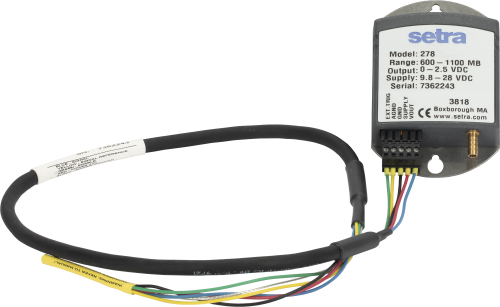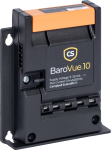
Resides inside weather proof enclosure






Resumen
The CS100 measures barometric pressure for the range of 600 to 1100 mb. This range equates to from below sea level (as in a mine) up to 12,000 feet above sea level. Designed for use in environmental applications, the CS100 is compatible with all Campbell Scientific dataloggers.
Leer másVentajas y características
- Adecuado para montar en armarios Campbell Scientific
- Bajo consumo
- 3 años de garantía
- Disponibles opcionalmente versiones de 500-1100MB y 800-1100MB--contacte con nosotros
- Un circuito de conmutación integrado limita el consumo de energía al ciclo de medición
Imágenes




Productos similares
Descripción detallada
The CS100 is a Campbell Scientific version of Setra's model 278 barometer. It uses Setra’s Setraceram capacitive sensor and IC analog circuit to measure barometric pressure.
The CS100 is encased in a stainless steel and polyester case fitted with an 1/8 in. barbed fitting for pressure connection. It includes an internal switching circuit that allows the datalogger to power the barometer only during measurement, which reduces power consumption.
Especificaciones
| Measurement Description | Barometric pressure |
| Signal Type/Output | Analog voltage |
| -NOTE- | 1 hPa = 1 mBar |
| Pressure Range | 600 to 1100 hPa |
| Long-Term Stability | ±0.1 hPa per year |
| Response Time | < 100 ms |
| Resolution | ±0.01 hPa |
| Excitation | 9.5 to 28 Vdc |
| Elevation | ~609.6 m (2,000 ft) below sea level (as in a mine) to 3,657.6 m (12,000 ft) above sea level |
| Accuracy |
|
| Linearity | ±0.4 hPa |
| Hysteresis | ±0.05 hPa |
| Repeatability | ±0.03 hPa |
| Signal Output | 0 to 2.5 Vdc |
| Warm-up Time | < 1 s |
| External Trigger Voltage |
|
| Current Consumption |
|
| Temperature Range | -40° to +60°C |
| Cable Diameter | 0.8 cm (0.3 in.) |
| Cable Length | 0.8 m (2.5 ft) |
| Dimensions | 9.1 x 6.1 x 2.5 cm (3.6 x 2.4 x 1.0 in.) |
| Weight | 135 g (4.8 oz) |
Compatibilidad
Nota: lo siguiente muestra información de compatibilidad notable. No es una lista de todos los productos compatibles.
Dataloggers
| Producto | Compatible | Nota |
|---|---|---|
| CR1000 (retired) | ||
| CR1000X | ||
| CR300 | ||
| CR3000 (retired) | ||
| CR310 | ||
| CR350 | ||
| CR6 | ||
| CR800 (retired) | ||
| CR850 (retired) |
Miscelaneo
| Producto | Compatible | Nota |
|---|---|---|
| GRANITE 6 |
Información de compatibilidad adicional
Datalogger Considerations
A 2.5-ft cable is supplied with the sensor for connection to the datalogger. The cable connects to a control port, single-ended analog input terminal, 12 V power terminal, and ground terminal on the datalogger.
Mounting
The CS100 is typically mounted next to the datalogger inside an ENC12/14 or larger enclosure. The very small ENC100 is available for housing the CS100 separately, in its own enclosure.
Documentos
Folletos producto
Preguntas frecuentes
Número de FAQs relacionadas con CS100: 9
Expandir todoDesplegar todo
-
Noisy measurements may be caused by several factors:
- The sensor was not allowed to warm up adequately.
- The sensor is placed in an electrically noisy environment, which makes other analog measurements noisy.
- The power supply for the sensor or station is dirty. (There is not a clean regulated voltage.)
-
Yes, but only if certain conditions are met:
- The sensor resides in a non-condensing environment.
- The vent tube accessing the high humidity environment is extremely well desiccated to keep any moisture from reaching the sensor’s components. Moisture in the sensor will damage the sensor, often to an un-repairable state.
-
Either the CS100 or the CS106 can fit inside an ENC100. For more information, refer to the Specifications information on the ENC100 product page.
-
In most cases, enclosures and buildings have enough little spaces for the pressure to stay at equilibrium with the outside pressure. Therefore, the sensor does not need to be vented to the outside. It is possible, however, that the rate at which the pressure equalizes is slowed by being in an enclosure, but the rate change usually is not noticeably significant.
If the sensor resides in an absolutely air-tight environment, and the pressure outside this environment needs to be measured, then the sensor will need to be vented to the outside. However, venting to the outside may change the rating of the enclosure or associated inside environment.
-
For a reading in millibars, the multiplier is 0.240, and the offset is 500. To convert the millibar reading to different units, add an equation to the code.
To correct the pressure to sea level, see the “Correcting Pressure to Sea Level” section in the CS100 instruction manual or in the CS106 instruction manual. Alternatively, use Short Cut for Windows to generate the program, and, when prompted, enter the appropriate site elevation.
-
The manufacturer recommends calibration on a yearly basis. However, conformance to published standards or regulations may require this on a more frequent basis.
-
Generally, these sensors are designed to measure the pressure of the environment where they are installed. The CS100 or CS106 can measure the air pressure within a snowpack if the enclosure is adequately sealed away from the snow while allowing the vent to have access to the snow. Note that it may be difficult to accomplish this.
-
It is possible that an older version of Short Cut is being used. Download the latest version of Short Cut.
If the latest version of Short Cut has already been downloaded, open the program.
- Go to Tools | Options and make sure that the Enable Creation of Custom Sensor Files box is checked.
- In the Generic Measurements folder, right-click the type of measurement to be made for the sensor, and select Create Custom Sensor.
- Set the fields according to the sensor’s specification, hide those fields that the user does not need to see after being set, and save the custom sensor file settings with the Save As button.
Casos de aplicación
Everglades National Park is the largest tropical wilderness in the United States and was created......leer más
Pont del Petroli was built in the 1960s to enable the transfer of oil from......leer más




